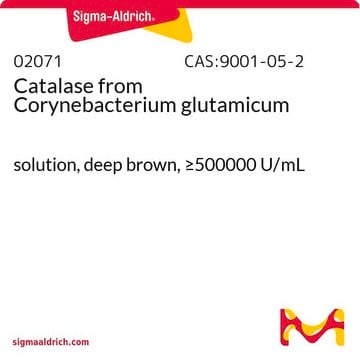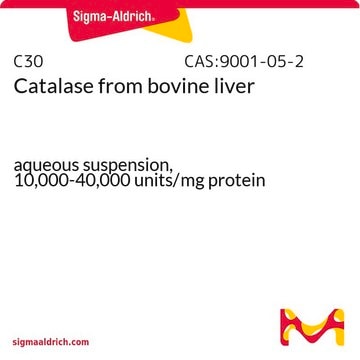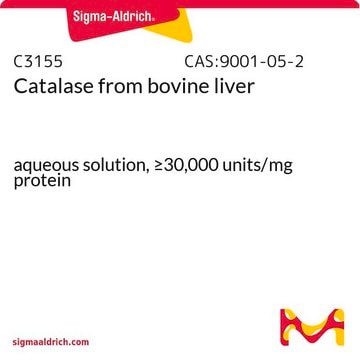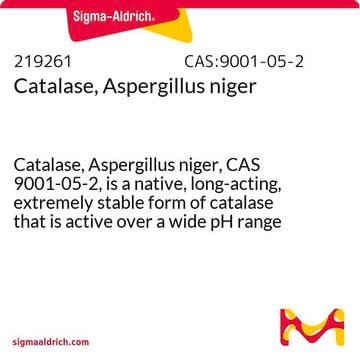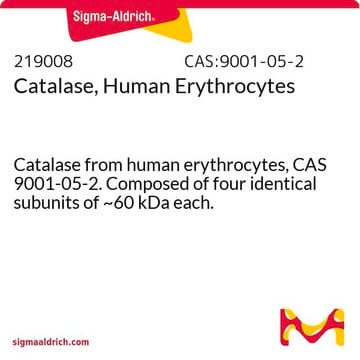60634
Catalase from Micrococcus lysodeikticus
solution, dark brown
Sign Into View Organizational & Contract Pricing
All Photos(1)
About This Item
Recommended Products
biological source
bacterial (Micrococcus lysodeikticus)
Quality Level
form
solution
specific activity
65,000-150,000 U/mL
mol wt
Mr ~230000
technique(s)
microbe id | metabolite detection: suitable
color
dark brown
solubility
0.05 M phosphate buffer pH 7.0: soluble, clear, brown (1:10)
Protein ID accession no.
UniProt accession no.
shipped in
wet ice
storage temp.
2-8°C
InChI
1S/C9H10O3/c1-2-12-9(11)7-3-5-8(10)6-4-7/h3-6,10H,2H2,1H3
InChI key
NUVBSKCKDOMJSU-UHFFFAOYSA-N
General description
Research area: Cell Signaling
Catalase (CAT) is an antioxidant enzyme, encoded by the CAT gene family. The enzyme is ubiquitously expressed in most of the aerobic organisms.
Catalase (CAT) is an antioxidant enzyme, encoded by the CAT gene family. The enzyme is ubiquitously expressed in most of the aerobic organisms.
Application
Catalase from Micrococcus lysodeikticus has been used to eliminate excess of hydrogen peroxide production during sugar analog synthesis by in vitro biocatalytic cascade. It has also been used as a standard to evaluate oxidative stress by indirectly measuring catalytic activity.
Biochem/physiol Actions
Catalase rapidly converts hydrogen peroxide to oxygen and water. It exhibits antioxidant activity and elicits a defense mechanism against reactive oxygen species (ROS). Catalase plays a role in neutralizing noxious hydrogen peroxide in nature as well as in various industries such as textile, pharma, and dairy. Micrococcus lysodeikticus catalase is a heme-containing protein.Catalase, along with various key cellular systems involved in hydrogen peroxide (H2O2) processing, plays a key role in regulating cellular redox balance and aids in cellular and intercellular signaling.
Unit Definition
1 U corresponds to the amount of enzyme which decomposes 1 μmol H2O2 per minute at pH 7.0 and 25 °C
Signal Word
Danger
Hazard Statements
Precautionary Statements
Hazard Classifications
Resp. Sens. 1
Storage Class Code
10 - Combustible liquids
WGK
WGK 1
Flash Point(F)
Not applicable
Flash Point(C)
Not applicable
Personal Protective Equipment
dust mask type N95 (US), Eyeshields, Gloves
Choose from one of the most recent versions:
Already Own This Product?
Find documentation for the products that you have recently purchased in the Document Library.
Customers Also Viewed
Margarita Florencio et al.
Comparative biochemistry and physiology. Part A, Molecular & integrative physiology, 242, 110654-110654 (2020-01-12)
Organisms are exposed to multiple environmental factors simultaneously to which they often respond behaviorally, morphologically and/or physiologically. Amphibian larvae are quite plastic and efficiently adjust their phenotype and physiology to the reigning local conditions. Here we tested whether the combination
Physiological mechanisms of adaptive developmental plasticity in Rana temporaria island populations.
Pablo Burraco et al.
BMC evolutionary biology, 17(1), 164-164 (2017-07-08)
Adaptive plasticity is essential for many species to cope with environmental heterogeneity. In particular, developmental plasticity allows organisms with complex life cycles to adaptively adjust the timing of ontogenetic switch points. Size at and time to metamorphosis are reliable fitness
Ivan Gomez-Mestre et al.
PloS one, 8(12), e84266-e84266 (2013-12-21)
Many amphibian species exploit temporary or even ephemeral aquatic habitats for reproduction by maximising larval growth under benign conditions but accelerating development to rapidly undergo metamorphosis when at risk of desiccation from pond drying. Here we determine mechanisms enabling developmental
An improved procedure using ferricyanide for detecting catalase isozymes.
W Woodbury et al.
Analytical biochemistry, 44(1), 301-305 (1971-11-01)
Hessam Sepasi Tehrani et al.
Progress in biophysics and molecular biology, 140, 5-12 (2018-03-14)
Catalase is one of the firsts in every realm of biological sciences. At the same time it also has a number of unusual features. It has one of the highest turnover numbers of all enzymes. It is essential for neutralizing
Our team of scientists has experience in all areas of research including Life Science, Material Science, Chemical Synthesis, Chromatography, Analytical and many others.
Contact Technical Service
